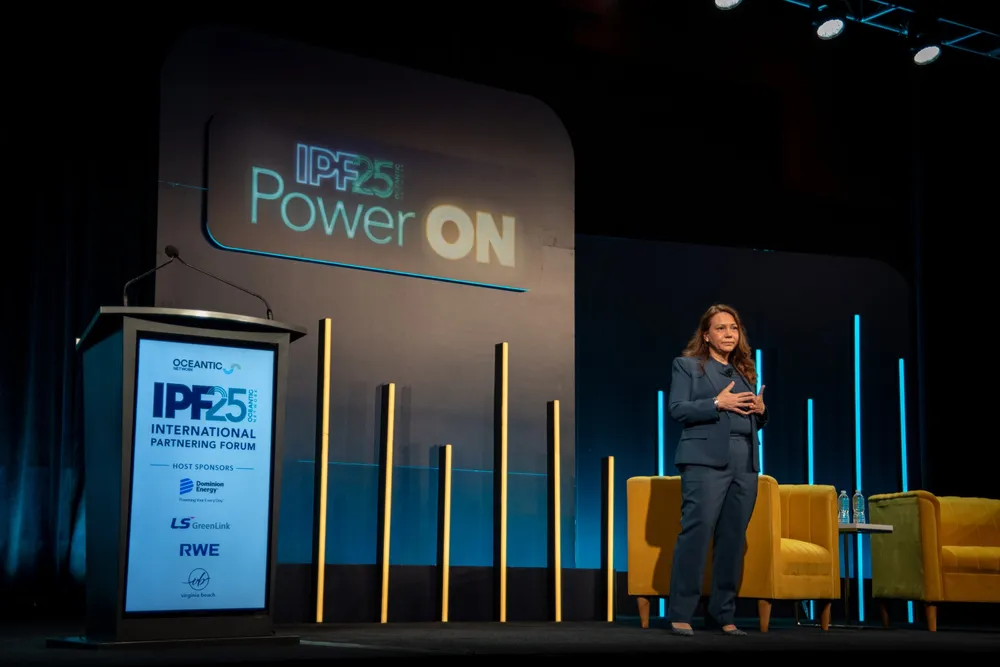'Strength on strength': US offshore wind gathers for reset under Trump
Industry group's annual supply chain conference was visibly smaller amid President's opposition, but attendees were optimistic of industry's resurgence

US offshore wind is down but not out, and will persevere despite concerted opposition, Oceantic Network CEO Liz Burdock said in her opening of the 2025 International Partnering Forum (IPF).
“Our opponents are loud, and they're organised and they're holding election leaders accountable to their demands,” she told last week's event.
“It's time we respond with strength on strength,” she said, vowing: “No more passive storytelling, no more silence while the narrative is shaped by others.”
Words of defiance from an industry filled with promise but now on the ropes under President Donald Trump’s relentless attacks.
The annual supply chain forum was held in Virginia Beach, Virginia, host city for the nation’s most successful project so far, Dominion Energy’s 2.6GW Coastal Virginia Offshore Wind (CVOW) in construction 27 miles (43km) off the coast.
Trump’s Inauguration Day memorandum freezing sector leasing and permitting also called for reviews of existing projects towards ‘terminating or amending” them, with Empire the latest and most high-profile victim. Interior Secretary Doug Burgum issued a stop-work order based on "new information" obtained through the Trump review that put cast doubt on the legitimacy of its permits
This was “not just a fully permitted project, but a project that is that has been fully financed. All the contracts are not just signed, but are being executed,” said Josh Kaplowitz, lead offshore wind attorney at Troutman Pepper Locke law firm during a panel on Trump’s memorandum.
While Equinor has publicly mulled taking the administration to court, the rest of the industry seems to be putting its head down and hoping to stay off Trump’s radar while quietly advocating for offshore wind as critical to the nation’s all-of-the-above energy strategy, IPF attendees said.
“There's a declared National Energy emergency and a desire to see revitalised US manufacturing,” RWE’s chief executive in the US Sam Eaton said during the plenary. “That's our moment for offshore wind. America needs offshore wind to be mainstream.”
Visibly smaller event
The show was visibly smaller than in previous years, and developers’ presence was subdued, with none hosting a booth.
Dominion clearly headlined the event, with more than half of the project already completed on-track towards commercial operations by the end of next year.
The Ventus Awards are given by Oceantic Network in recognition of efforts to further the industry.
The biggest news to come out of the event was LS GreenLink’s groundbreaking on its $700m cable manufacturing plant in Chesapeake, Virginia.
LS GreenLink president Koo Bon-kyu said the company remains bullish on the US sector despite the recent turmoil.
“We're looking at this as an industry that will last over 20 to 30 to 40 years,” Koo said.
This view was widely shared at IPF.
“It was always going to be a long-term play,” said Andy Ziegwield, director of business development for ocean monitoring firm Bedrock. “Maybe this delay will allow more US companies to get into the industry,” he added.
Many are confident that future administrations – maybe even sooner with upcoming Congressional elections – will see the need for offshore wind as power demand particularly in Northern Virginia’s data centre hub is expected to skyrocket 6% annually through the end of the decade.
Others were less optimistic, seeing Trump introducing insurmountable political risk for long term, multibillion infrastructure projects that will wither the sector.
The industry also faced major cost and regulatory challenges prior to Trump’s memorandum, with surging inflation starting in 2022 sending sector costs spiraling. Three-quarters of offtake contracts were withdrawn or renegotiated at often much higher rates.
Many said they were open to more sector business but weren't necessarily optimistic at least in the next four years, and some added Trump's hostility encouraged them to seek bluer waters in larger markets abroad.
Amid the turmoil, though, Oceantic remains bullish, and has set New York City as host for its next IPF, faithful that Empire – and the nation’s industry – will get back on track.
(Copyright)